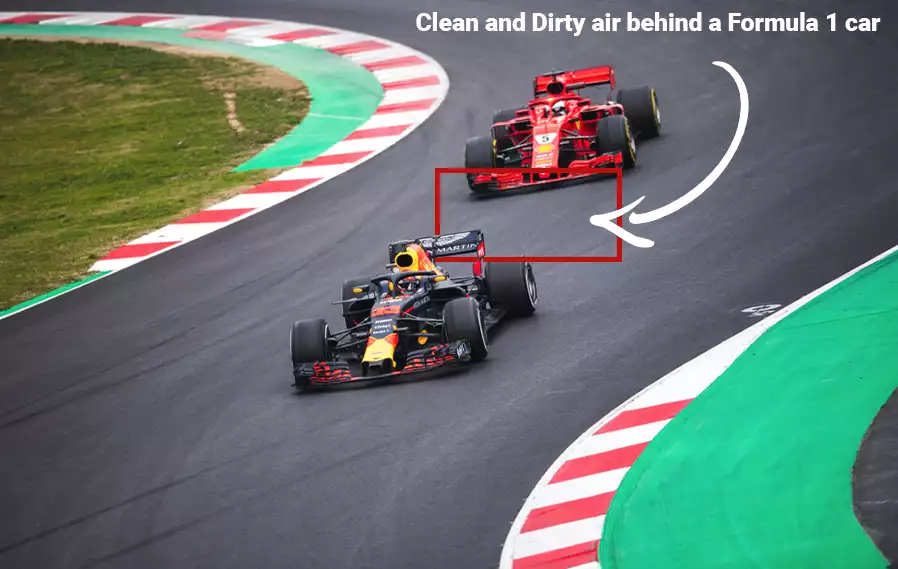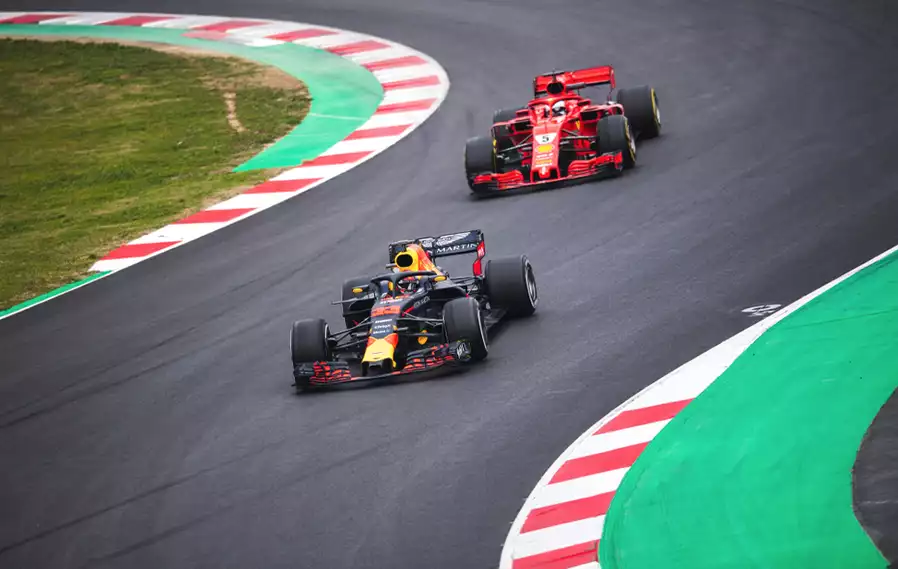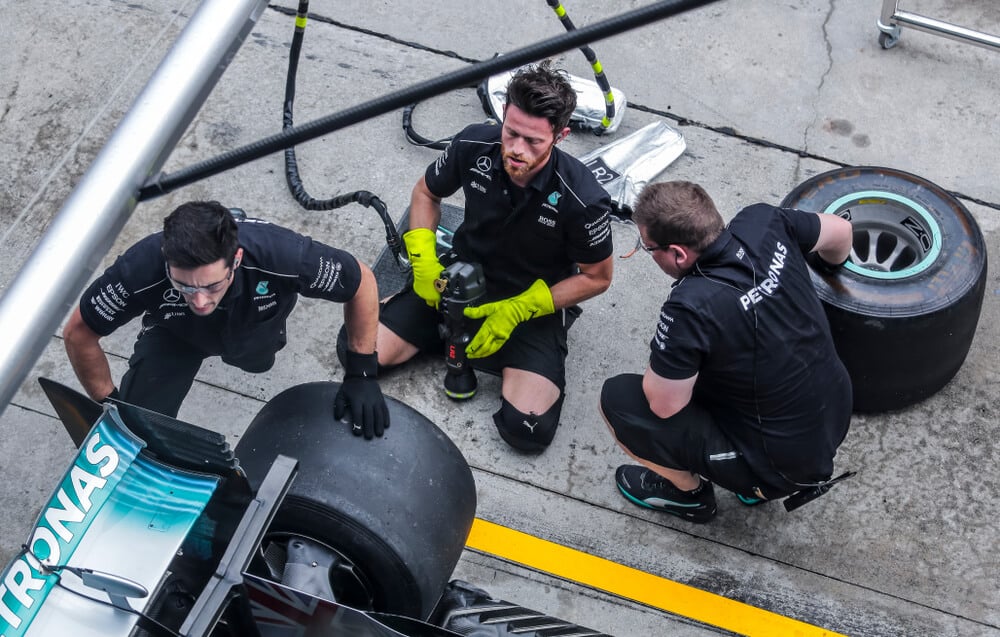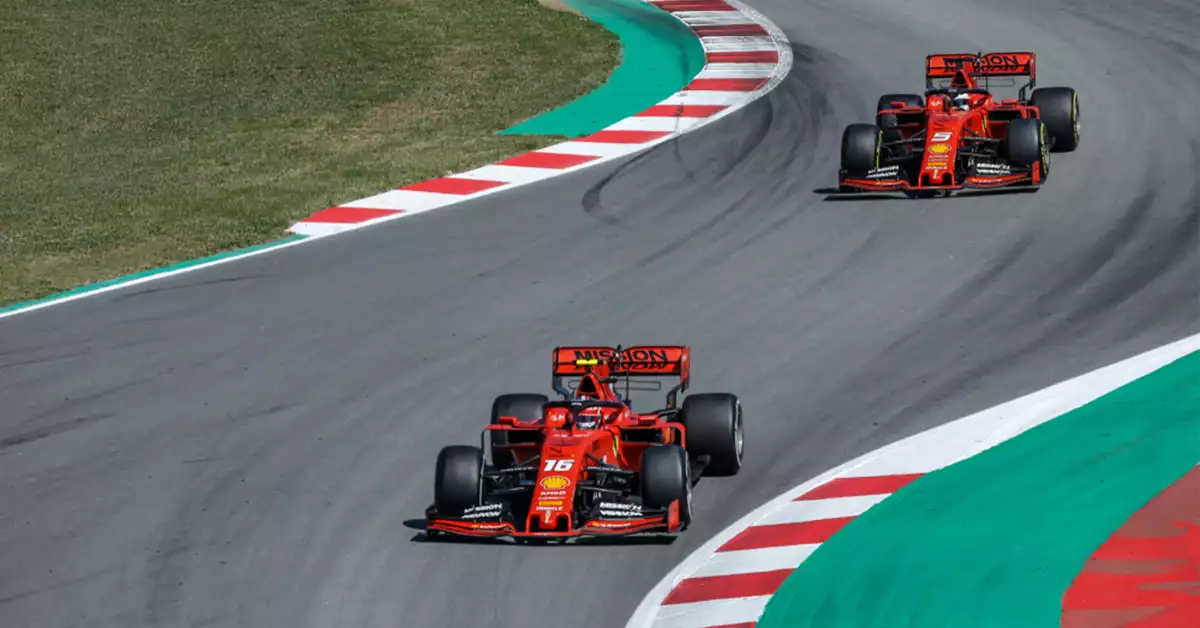Formula 1 cars have to deal with more than just tight turns and speedy competitors. With each lap, they ingest large quantities of air – and with that air comes a host of potential problems.
That’s why teams spend so much time and money optimizing their cars’ aerodynamics; it’s not just about making the car look fast, but also about making sure it can deal with the challenges posed by the air around it.
In this article, we’ll take a look at two of the biggest challenges that cars face when it comes to air: clean and dirty air in Formula 1.
We’ll also look at how the new 2022 regulations may change things.
Table of Contents
Watch this video to undertsand how clean and dirty air works in Formula One.
What is the difference between clean and dirty air in F1?
Clean air is the term used to describe the air around a car that is not affected by the exhaust from another car. Dirty air, on the other hand, is the term used to describe the exhaust-filled air surrounding a car that is being overtaken. When a car passes through clean air, it experiences less drag and therefore has an advantage over cars in dirty air.
While dirty air can be frustrating for drivers trying to overtake, it can also be used strategically, as leading drivers can use it to block their opponents and prevent them from making a move.
The study of clean air and dirty air is an important part of Formula 1 racing, and teams are always looking for ways to gain an advantage over their rivals.
Key takeaways
- Clean air is the air that surrounds a car when it is in front of another car.
- Dirty air is the air that surrounds a car when it is behind another car.
- Dirty air can make it harder for a car to drive, and it can also cause turbulence.
- Clean air is less turbulent and therefore it is easier for a car to drive in.
- Teams will often try to position their cars in clean air during a race, as it gives them an advantage.

What is dirty air in F1?
Dirty air in context of Formula 1 can be defined as the air that is disturbed by the cars as they move around the track. This air can cause a decrease in performance for the drivers, as it can make it more difficult to see and breathe.
As we’ve mentioned that dirty air refers to the air that is expelled from the rear of an F1 vehicle. It can alos be referred to as the wake of a Formula One vehicle.
Dirty air makes Formula 1 vehicles harder to follow because the cars cannot create as much downforce when dirty air passes over them.
The leading car will often use dirty air to block their opponents and prevent them from making a move.
The leading car will often use dirty air to block their opponents and prevent them from making a move.
The lead car will disturb the airflow around the following car, causing it to experience turbulence and reduced grip. This can be a particular problem at high speeds, as the dirty air can cause the following car to be thrown off course or even into a spin.
It can also be dangerous for the driver of the following car, as they may be momentarily blinded by the spray of dirt and water that is thrown up by the lead car’s tyres
Hence, It is important for teams to take this into consideration when making their pit stop strategies as the amount of time a car spends in dirty air will have an impact on its performance.
What causes dirty air?
When an F1 car moves through clean air, it disturbs it and makes it turbulent, which makes the air dirty. With all the wings and other downforce parts on an F1 car, the air is very messed up. Since F1 cars go so fast, the dirty air they leave behind can be seen for several seconds.
It’s safe to say that the dirty air is caused by a car moving through clean air. It is difficult to visualise since we cannot see how air moves when a vehicle passes through it, yet the effects of dirty air are evident when we see a following car struggle to keep up with the lead car.
It's safe to say that the dirty air is caused by a car moving through clean air. It is difficult to visualise since we cannot see how air moves when a vehicle passes through it...
Dirty air can also be caused by the tyres of an F1 car, as they are always spinning at high speeds. When the tyres make contact with the ground, they throw up dirt and water which can also contribute to dirty air.
How does dirty air affect an Formula 1 car?
From the above discussion, it is obvious that dirty air can have an impact on performance of a car. Let’s take a more detailed look at how dirty air affects an F1 car.
Positive effects
Well, there actually are some positive effects of dirty air, believe it or not. But off course only for the car in front, not the one behind.
The main one is that it can act as a form of protection for the car in front.
If you’re in the lead, the dirty air that your car is kicking up will make it harder for those behind you to overtake. They will have to deal with reduced grip and visibility, which gives you a bit of an advantage.
Another positive effect is that it can help you to cool your car down. When the dirty air hits the brakes, it helps to dissipate the heat and prevent the brakes from overheating.
Negative effects
If you’re not in the lead, then dirty air can have a number of negative effects on your car.
The main one is that it reduces grip and visibility. This can make it very difficult to drive, especially at high speeds.
It can also cause your tyres to overheat, as they have to work harder to displace the dirty air. This can lead to tyre degradation and eventually a puncture.
Another problem with dirty air is that it can cause your car to be thrown off course or even into a spin. This is because the turbulence can disrupt the downforce that is keeping your car glued to the ground.
What is clean air in F1?
As you might expect, clean air is the opposite of dirty air. It is the un disturbed airflow that a car experiences when it is not following another car.
Clean air is very important for an F1 car, as it helps to maximise downforce and grip. This allows the car to go faster through corners and also improves braking performance.
As clean air rushes over a Formula 1 vehicle, it exerts an impact known as downforce, pushing the car into the ground. With the 2022 aerodynamic rule changes , air is also drawn in via the Venturi tunnels under the car’s floor, resulting in increased downforce.
Read more about how clean air helps creating a slipstream for F1 cars.
In Formula 1, clean air is better because the airflow over each aerodynamic part of the F1 car can affect it.
In Formula 1, clean air is better because the airflow over each aerodynamic part of the F1 car can affect it. This means that the car will produce the most downforce possible in clean air, letting it go faster around corners.
What causes clean air in F1?
The main difference is that in order for there to be clean air, there can’t be any cars around to disturb it. This usually happens when a car is out in front on its own and not being followed by another car.
Another factor that can contribute to clean air is the weather. If it is windy, then this can also help to keep the air around a car clean.
How does clear air affect an F1 car?
Just like dirty air, clean air can also have an effect on the performance of a car. But as you might expect, the effects are the opposite. Let’s take a look at how clean air affects an F1 car.
Possitive effects
One of the main benefits of clean air is that it helps to reduce drag on the car. This is because dirty air contains a lot of turbulence and particles which create drag on the car.
By reducing the amount of turbulence and particles in the air, you can significantly reduce drag on the car.
Clean air can also help to improve engine performance. This is because a clean engine runs more efficiently than a dirty engine.
When an engine runs more efficiently, it produces less heat and emissions. This means that the engine can run at a higher RPM without damaging or polluting the environment.
Overall, clean air is an important factor in Formula 1 car performance. By reducing turbulence and particles in the air, you can improve aerodynamic efficiency and engine performance.
Negative effects
Well, there are some negative aspects to clean air. One of these is that it can make it difficult for the drivers to overtake. This is because the cars behind them have less air resistance to fight against, so they can catch up more quickly.
Another downside to clean air is that it can make the cars more sensitive to changes in the weather. For example, if there is a sudden gust of wind, the car may lose traction or even flip over.
Overall, the clean air doesn’t have any potential drawbacks as it is ideal for aerodynamics which plays an important role in performance of F1 car.
Frequently asked questions about clean air and dirty air
What is the difference between clean and dirty air in F1?
What is the difference between slipstream and dirty air?
Is dirty air good or bad in F1?
Regulation changes for 2022 helps to reduce dirty air
Now, let’s take a look at how the new regulations for 2022 will help to reduce dirty air.
As we know, the main cause of dirty air is turbulence. By reducing the amount of turbulence in the air, we can reduce the amount of dirty air. The new regulations for 2022 include a number of changes that will help to reduce turbulence.
F1’s new regulations drastically trim the side of the cars, removing the array of carbon fiber foils that are currently used to shape the airflow around the car. In doing so, it will make it much harder for one car to influence the airflow around another, meaning that dirty air will become less of an issue.
F1's new regulations drastically trim the side of the cars, removing the array of carbon fiber foils that are currently used to shape the airflow around the car.
Formula 1’s plan to clean up the air implies that the body shape is more uniform and simple. Getting rid of all the winglets and bargeboards on the cars and making the wings simpler made the air flow smoother and the air coming off the back of the cars cleaner.
Despite the fact that the new regulations will help to reduce dirty air, you can never completely get rid of it. This is because even the slightest disturbance in the air can cause dirty air and you can’t stop it in open wheel racing.
Conclusion
So, there you have it! That is everything you need to know about clean and dirty air in Formula 1. Remember, the new regulations for 2022 will help to reduce dirty air, but you can never completely get rid of it. Next time you’re watching a race, keep an eye out for the dirty air and see how it affects the cars!
Article sources
Learn more about Formula One
Want to learn more about F1? Then visit our Formula 1 glossary and dictionary.




